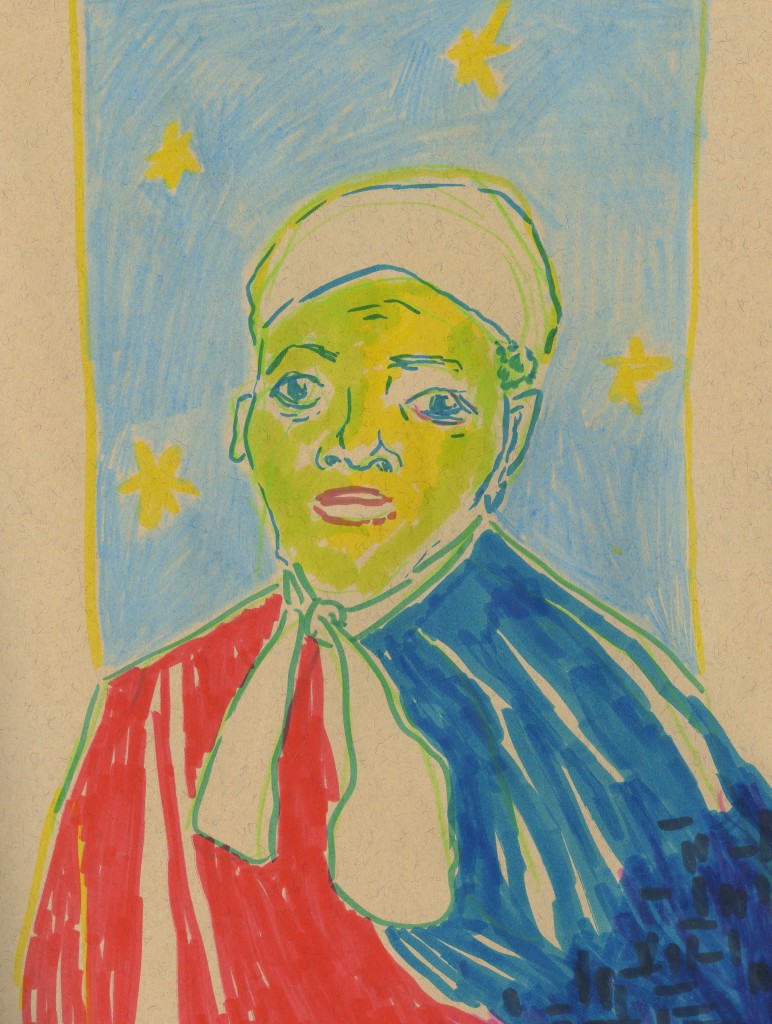imagesBy(Alex)

I remember blues. In the center, the painting description said, Harriet Tubman is clear-cut and strong. My eyes wandered to the sides of the painting. Who are the not-strong?
As it turns out, I had only remembered the not-strong. I had remembered Harriet in a deep blue, which leaks across the rest of the campus in different, calming shades. In Jacob Lawrence’s painting, Harriet and the Promised Land, Harriet is actually in a brilliant red as she drives the chariot north.
Strange. But memory is hardly accurate. Blue is the sky, the leaves pointed towards promised land, a bird trilling triumphant, and the woman behind Harriet, comforting a woman in yellow. Why had I associated Harriet with the color of comfort? Only one other character is dressed in red. A small girl at the bottom faces Harriet and cheers the wagon’s crossing.
It looks like a race scene. The characters are about to cross a finish line visible to us only by the color change, a faint green to a lush cousin, though I remind myself that in reality, the boundary between Canada and the US is nothing so obviously visual. A girl in red and her companion in tan stand on a part of the land I cannot see. I assume she’s on the greener side of grass, because she bears gifts and joy for the wagon.
The horse and the chariot zoom by with no obstacle. Loud colors. I can hear the bird and the cheering and the leaves and the gallop. It is an exhilarating depiction of almost. And I am reassured by the knowledge of the present; Harriet Tubman completed the journey 19 times.
Lawrence paints this scene as a welcome, versus an attack or invasion. Is the difference merely in what the people bear in their hands? Is it the warm salute and smiles in contrast to the weary and forward-looking of the wagon-riders?
How did he paint the word home to the diverse viewers in the gallery, to people who have crossed a multitude of borders? Where do I stand in this painting? Do I really have that much in common with the man standing next to me?
The museum is the strangest crossing space of all.
Borders thrive in imagination as abstract shapes in paper, guns, and law. Or, in select parts of the world, they exist as physical walls. I’ve peered at different shades of green myself. I’ve looked at crazy greens swallow the sky at the 38th parallel. Land untouched for half a century because of active mines left behind from the war. I once read a National Geographic article on how the DMZ is one of the best-protected parcels of nature in the world. The rest of the world seems to have moved on.
When I stood there, I imagined my grandmother and her family crossing the wild before it was called untouched. There was no fanfare for her in the south - probably only tense silence before gunfire. She was leaving.
I never asked her for those stories, and now it is too late. So I imagine them.
So did Jacob Lawrence. The paintings reimagine the histories absent in mainstream nods to black folk in America — a self-conscious positioning of Jacob Lawrence’s queries regarding identity and story through the story of another. The Migration of the Negro series (1941) and cycles depicting various black revolutionaries become, to future viewers, reflections on the art subjects and the artist in filling holes and confronting what it meant and what it means for a culture to be in vogue. They are similar to today’s conversations regarding authenticity and appropriation. What borders surround a people’s culture? Who is allowed to cross?
The promised land Jacob Lawrence paints falls far from most border-crossing, home-searching realities. But it is a true depiction in that sense. Whatever many migrants imagine across borders often tumbles upon destination, in reality. We can cross lines now with crazy speed, but the pain a stupid invisible line can scatter on the separated is undeniable. My family now lies separated across oceans and hiss-inducing flight prices. But so do many families.
So I wonder at the joy in this painting of crossing and am comforted by the hope it reclaims. Jacob Lawrence makes the line visible. It is a nod to the realities and sacrifices of those migrants, to those who are forced to move, to the resilience of the travelers and their progeny. A challenge to people who refused to see the traveling of Jacob Lawrence’s own art. A story of an arrival, not of leaving.
